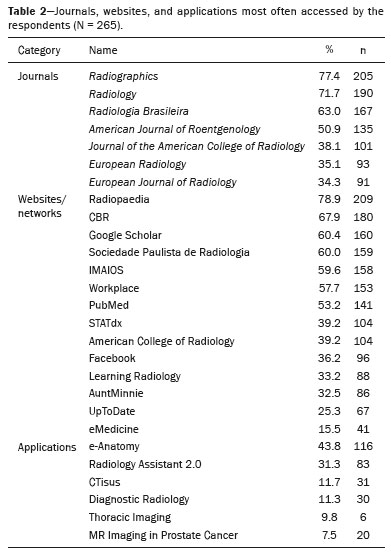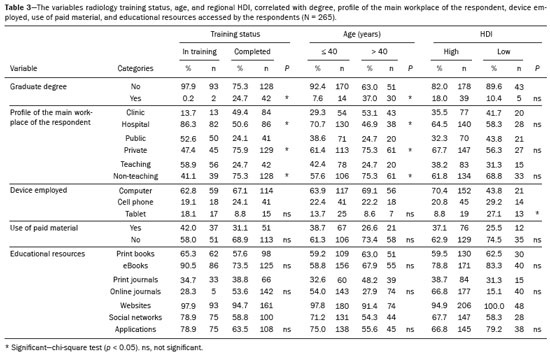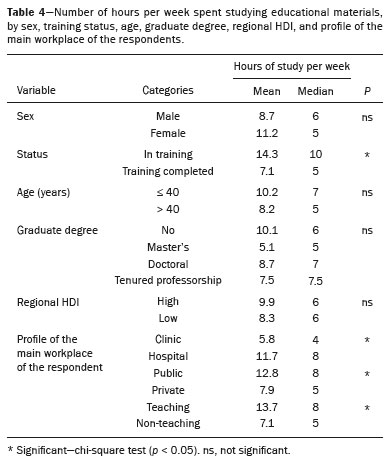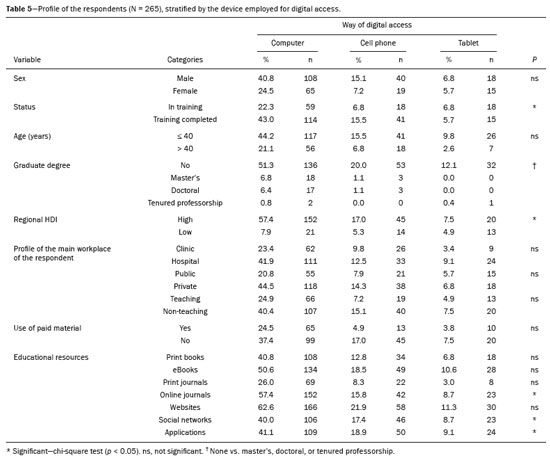Radiologia Brasileira - Publicação Científica Oficial do Colégio Brasileiro de Radiologia
AMB - Associação Médica Brasileira CNA - Comissão Nacional de Acreditação
 Ahead of Print
Ahead of Print
|
ORIGINAL ARTICLE
|
|
Analysis of the use of educational materials by radiologists and radiology residents in Brazil: paradigm shift |
|
|
Autho(rs): Letícia Motono Chojniak1,a; Rony Klaus Isberner2,b; Juliana de Oliveira Souza3,c; Valdair Francisco Muglia4,d; Almir Galvão Vieira Bitencourt3,e; Rubens Chojniak3,f |
|
|
Keywords: Radiology; Teaching materials; Education, continuing; Multimedia. |
|
|
Abstract: INTRODUCTION
The technological evolution that occurred in various medical fields over the last 35 years was mainly driven by digital automation, which has resulted in structural changes in the entire service network, as well as in the behavior of health care professionals, who needed to adapt to the innovations of the digital age. Diagnostic imaging was one of the medical specialties most affected by that evolution, because of the introduction of new digital equipment and the need for professionals in order to improve the technological resources, and a culture of continuing education developed. Digital literacy became fundamental for that process, not only in medical schools, but also for health care professionals already in the job market. New technologies and their innovations have revolutionized the way people communicate, thus increasing the quantity and quality of the information available, as well as the speed of information exchange(1). Prior to the widespread adoption of electronic media, most educational resources in the field of radiology were print books and print journals. The need for broader, faster searches for information in the area of diagnostic imaging prompted radiologists and radiology residents to adopt the use of other media resources, such as computers, cell phones, and tablets(2). Virtual tools and environments have been shown to play an important role in learning(3). Mobile technologies are now increasingly used by students and educators around the world, in order to access information, rationalize/simplify time management, and facilitate learning in an innovative way(4,5). The use of web platforms to interact, generate, access, and disseminate information has become common practice among health care professionals(6–9). When it is necessary to obtain information quickly and easily, the “technological environment” modifies the behavior of health care professionals in their daily lives, putting them into a very close relationship with the available digital resources. That interaction breaks paradigms and aids in the personal and professional development of the individual. The observation of radiology residents and radiologists leads us to suspect that the educational reference materials used have shifted from standard print material to internet resources. However, there have been few studies documenting that change in behavior. Knowledge of the preference for and frequency of use of the various sources of print information or electronic media consulted by radiologists who work in various settings and types of institutions, at different stages in their careers, could be useful for specialty societies, coordinators of training programs, and managers of major radiology centers. Such knowledge would make it possible to outline a strategy for providing access to educational resources, in terms of the choice of books, internet resources, and licenses for selected sites, as well as providing specialist physicians and residents in the area with information regarding the use of resources and the preferences of their colleagues. Therefore, the objective of this study was to profile the use of educational resources by radiologists and radiology residents in Brazil. MATERIALS AND METHODS This was a cross-sectional, predominantly quantitative, observational study, with descriptive characteristics. Prospective respondents were sent, via e-mail, an invitation letter, an informed consent form, and an electronic questionnaire on the use of educational resources, through the communication channel of the Teaching, Improvement, and Medical Residency Committee of the Colégio Brasileiro de Radiologia e Diagnóstico por Imagem (CBR, Brazilian College of Radiology and Diagnostic Imaging), which brings together radiologists (members of the CBR) and resident physicians at radiology and diagnostic imaging centers affiliated with the CBR. The questionnaire was sent via the Google forms tool, for data distribution and collection, and comprised the following items: 1. Work profile:
2. Profile of access to educational materials:
On the questions related to a preference for certain educational resources, respondents were allowed to provide multiple answers, as well as to write in answers not included in the list of options. A total of 265 professionals, including radiology residents and board-certified radiologists, some with specialist titles or a certificate of competence in diagnostic imaging, completed and returned the questionnaire. All of the respondents gave written informed consent for the anonymous use of their data. On the basis of the data obtained, descriptive statistics parameters were used, the usual measures of central tendency being adopted, together with the calculation of absolute and relative frequencies. Groups and subgroups were created according to the following selected categories: level of training—physicians in training (first-, second-, third-, or fourth-year residents) and trained physicians; academic degree—master’s, doctoral, or tenured professorship); type of workplace (public or private facility); frequency of use of resources (daily, weekly, monthly/rarely, or never); number of physicians working at the facility; regional human development index (HDI)—high HDI (southern, southeastern, or central-west region) or low HDI (northern or northeastern region); generation—Generation Y (< 40 years of age) or Generation X/Baby Boomers (≥ 40 years of age); simple frequency crossings between the level of training and the types of media used (journals, books, websites, social networks, and applications); absolute and relative frequency of region by HDI; frequency of each type of device used in order to access digital material (computer, tablet, and cell phone); and the specific source of each journal, website, and application. The analysis to determine the relationship among the subgroups for categorical variables was performed with Pearson’s chi-square test and Fisher’s exact test. For continuous variables, the Kruskal-Wallis test and Mann-Whitney U test were used. The information obtained from the questionnaires was tabulated in electronic spreadsheets and subsequently analyzed for significance in the various intersections. Values of p < 0.05 were considered significant. Questions that were unanswered were not included in the analysis. RESULTS Table 1 shows the characteristics of the 265 physicians who completed the questionnaire. The mean age of the respondents was 38.2 years (median, 35 years), and the mean length of experience was 10.8 years (median, 7 years). Of the 265 respondents, 170 (64.2%) were trained physicians, including 136 (51.3%) with specialist titles, and 95 (35.8%) were physicians in training, first-, second-, third-, and fourth-year residents accounting for 20, 22, 28, and 25, respectively. The area of expertise most often cited was ultrasound (in 80.0%), followed by computed tomography (in 77.7%), magnetic resonance imaging (in 59.2%), radiography (in 49.4%), mammography (in 32.1%), densitometry (in 17.7%), interventional radiology (in 10.9%), and nuclear medicine (in 1.5%). The region of Brazil that accounted for the greatest proportion of respondents was the southeastern region, where, 155 (58.5%) of the respondents worked, whereas 40 (15.1%) worked in the southern region, 39 (14.7%) worked in the northeastern region, 22 (8.3%) worked in the central-west region, and only nine (3.4%) worked in the northern region. 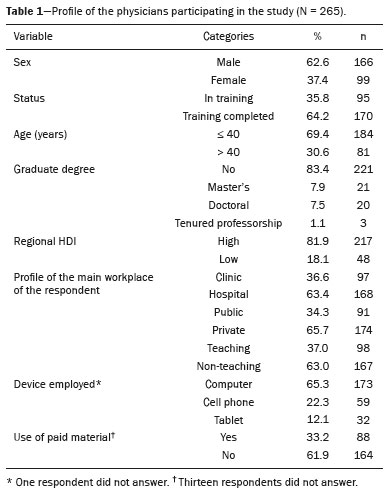 The educational resources most often used were websites (used by 92.4%), eBooks (used by 66.4%), online journals (used by 61.1%), applications (used by 60.7%), social networks (used by 57.3% ), print books (used by 47.9%), and print journals (used by 16.9%). Table 2 presents information about the journals, websites, and applications most often accessed by the respondents. Table 3 shows the correlations that the variables educational status (radiology resident or radiologist), age, and regional HDI had with the variables, academic degree, profile of the main workplace, digital access, use of paid material, and educational resources. As can be seen in Table 4, the mean time spent studying per week was 9.6 hours (median, 6 hours), although the time was longer among the physicians in training and among those whose main workplace was a hospital (rather than a clinic), a public facility (rather than a private facility), or a teaching hospital (rather than a non-teaching hospital). Physicians who had completed their residency or who worked in regions of the country with a high HDI reported using a computer more often than they used a cell phone or tablet (Table 5). DISCUSSION There are few data in the existing literature regarding the profile of radiologists, in Brazil or elsewhere, particularly in relation to the types of educational resources they use. This study profiles the use of educational resources by physicians in training and physicians trained in the field of diagnostic imaging, as well as the resources and types of media most often used by such physicians, together with some characteristics of the activities carried out by these professionals in their daily routine. Most of the respondents had completed their residency, were male, were under 40 years of age, had no graduate degree, worked in a region of Brazil with a high HDI, worked at a private hospital or clinic, had no academic affiliation, and had expertise mainly in the field of ultrasound or computed tomography. As a means of accessing the educational material, there was a trend towards greater use of computers (rather than cell phones or tablets). Most of the respondents choose to access educational materials that were available at no cost, websites and online journals being the sources most often accessed. The demographic characteristics of the respondents in our sample were in line with those reported in a recent survey conducted by the CBR, involving 12,868 radiologists (62.4% men), among whom the mean age was 46.1 years and 54.0% were under 40 years of age(10). In that study, as in ours, there was a greater number of physicians working in regions of the country with a high HDI, mainly in the southeastern region, especially among the radiologists in training, which may be related to the greater number of medical residency vacancies in diagnostic imaging in such regions. In addition, the technologically complex aspects of radiology are taught and practiced primarily in large cities, at specialized, regionalized, or referral facilities(10). In our sample, the physicians interviewed studied an average of 9.6 h per week. For those who worked at public hospitals and those with an academic affiliation, the mean weekly study time was nearly double that reported by those who worked at private clinics or hospitals. Overall, the mean weekly study time was longest among the residents. In our sample, the type of device used in order to access digital material was a computer, followed by a cell phone and a tablet. Some authors have conducted comparative studies of the use of mobile and fixed devices, in which factors such as socioeconomic status, skill level, and limited access to web resources via mobile devices influenced the decision to use a computer, as did the need to have a screen with a wider field of view(11). It is noteworthy that most health care professionals working in the field of diagnostic imaging already use computers to view images on larger screens and can use that same device for their studies. We found that the tendency to use cell phones and tablets was greater among the health care professionals who were under 40 years of age, the use of tablets being greatest among the youngest physicians and residents. A survey conducted by the Internet Steering Committee in Brazil, designated TIC Kids Online Brazil 2017, indicated that computers (desktops, laptops, and tablets) are losing ground, showing that the proportion of children using computers to access the Internet dropped from 90% in 2013 to 53% in 2017(12). These data demonstrate a trend toward a preference for the use of mobile devices (especially cell phones) by the younger generations. The ease of access and searching with digital tools, as well as the possibility of reading on different devices such as cell phones, tablets, and computers, make these resources highly attractive(13–15). However, some factors can be considered barriers to online research, such as the need to use passwords or usernames, too much information to digitize and little specific information to answer a defined question, the credibility of the source accessed, and having to pay for content(16). Most of our respondents stated that they prefer to use open access materials. However, the younger respondents (physicians in training) were slightly more likely to access paid content than were the radiologists who were over 40 years of age. There is a global trend toward making educational tools available at no cost, such tools already being standardized, collectively having been given the generic name of free open access medical (FOAM) education(17). Websites were the sources most often utilized in searches, being accessed by 254 of the 265 respondents. Although there was broad variation in the types of websites accessed, the predominant ones were those of specialty societies, scientific journals, and educational institutions; the point of convergence was the search for websites of highly credible institutions. There was also an impressive number of views of online journals and eBooks, followed by applications and social networks, mainly by the younger respondents. There was a trend toward greater use of applications and social networks by younger (Generation Y) respondents, those who were physicians in training, those who worked at public facilities, and those who worked in a region with a high HDI, the daily frequency of access, notably to social networks, in which residents were more significantly engaged, being higher among such respondents. Social networks can be quite useful as research tools because of their great popularity and widespread use, in Brazil and elsewhere, having a wide reach due to the number of connections established among the people who use them. In addition, the use of a social network is an easy-to-use, low-cost method of rapidly disseminating information(18,19). It is noteworthy that the global use of mobile devices, with their capacity for connectivity, integrated with the possibilities of social media, also provides a rich platform for innovative scientific experiences in student-directed learning(20). In our survey, scientific journals in the field of diagnostic imaging were also cited as common research sources. Among such journals, those most frequently accessed were Radiographics, Radiology, Radiologia Brasileira, and the American Journal of Roentgenology. Most of those journals publish review articles, which are generally the article type most sought after by health care professionals in training or seeking retraining. It is noteworthy that the journal most accessed by the respondents—Radiographics—publishes exclusively review articles and pictorial essays. In our sample, those research sources were typically accessed by radiologists who were under 40 years of age, worked in a region with a high HDI (especially in cities with more than a million inhabitants), and worked at a facility with more than 20 radiologists on staff, a computer being the device most often used to access them. Our study has some limitations. The data sample, obtained from answers to questionnaires sent via an online platform, was small in relation to the total number of radiologists working in Brazil. In addition, the number of respondents in certain subgroups was small. Furthermore, it is possible that the radiologists who completed the questionnaire were those with the greatest interest in continuing education and digital education, which could represent a self-selection bias. For some variables, certain approximations and generalizations were allowed. For example, the geographic regions of the country were stratified by HDI, although it is known that there are areas of high HDI in regions with low development and vice versa. In conclusion, our findings indicate that, on average, radiologists currently spend fewer than 10 h per week engaged in the study of educational material, although that number appears to be higher among radiology residents, as well as among those who work at hospitals (especially teaching hospitals) and public facilities. Our data also suggest that radiologists, while still in training or after graduation, predominantly use electronic and digital resources to access sources of educational material. In the present study, we have demonstrated the importance of using technological resources to obtain information in the field of diagnostic imaging by showing that the vast majority of our respondents employed such resources. Websites and online journals appear to be the most researched type of media most often utilized by radiologists and radiology residents. In addition, there appears to be a tendency for such professionals to use a computer to access digital media and to choose open access content over paid content. Acknowledgments This work was carried out with the support of the Brazilian College of Radiology and Diagnostic Imaging and the Brazilian National Council for Scientific and Technological Development. REFERENCES 1. Werthein J. A sociedade da informação e seus desafios. Ci Inf (Brasília). 2000;29:71–7. 2. D’Alessandro MP, Nguyen BC, D’Alessandro DM. Information needs and information-seeking behaviors of on-call radiology residents. Acad Radiol. 1999;6:16–21. 3. Pearce N, Weller M, Scanlon E, et al. Digital scholarship considered: how new technologies could transform academic work. Education. 2011;16:33–44. 4. Wallace S, Clark M, White J. ‘It’s on my iPhone’: attitudes to the use of mobile computing devices in medical education, a mixed-methods study. BMJ Open. 2012;2:e001099. 5. Chase TJG, Julius A, Chandan JS, et al. Mobile learning in medicine: an evaluation of attitudes and behaviours of medical students. BMC Med Educ. 2018;18:152. 6. Johnston MJ, King D, Arora S, et al. Smartphones let surgeons know WhatsApp: an analysis of communication in emergency surgical teams. Am J Surg. 2015;209:45–51. 7. Markham MJ, Gentile D, Graham DL. Social media for networking, professional development, and patient engagement. Am Soc Clin Oncol Educ Book. 2017;37:782–7. 8. Aragão JMN, Gubert FA, Torres RAM, et al. The use of Facebook in health education: perceptions of adolescent students. Rev Bras Enferm. 2018;71:265–71. 9. De Benedictis A, Lettieri E, Masella C, et al. WhatsApp in hospital? An empirical investigation of individual and organizational determinants to use. PLoS One. 2019;14:e 0209873. 10. Scheffer M, Cassenote A. O perfil do médico especialista em radiologia e diagnóstico por imagem no Brasil. São Paulo, SP: Colégio Brasileiro de Radiologia e Diagnóstico por Imagem; 2019. 11. Correa T, Pavez I, Contreras J. Digital inclusion through mobile phones? A comparison between mobile-only and computer users in internet access, skills and use. Information Communication & Society. 2020;23:1–18. 12. Núcleo de Informação e Coordenação do Ponto BR. TIC Kids Online Brasil. Pesquisa sobre o uso da internet por crianças e adolescentes no Brasil – 2017. São Paulo, SP: Comitê Gestor da Internet no Brasil; 2018. 13. Dziekaniak GV, de Moraes RPT, Medeiros JS, et al. Considerações sobre o E-book: do hipertexto à preservação digital. Biblos. 2010;24:83–9. 14. Maduku DK. Understanding behavioural intention towards e-books use: does gender really matter? In: Proceedings of 31st International Business Research Conference; 2015 July 27-29; Toronto, Canada. Toronto: Ryerson University; 2015. p. 1–15. 15. van der Velde W, Ernst O. The future of Ebooks? Will print disappear? An end-user perspective. Library Hi Tech. 2009;27:570–83. 16. Brennan N, Edwards S, Kelly N, et al. Qualified doctor and medical students’ use of resourcers for accessing information: what is used and why? Health Info Libr J. 2014;31:204–14. 17. Chan TM, Stehman C, Gottlieb M, et al. A short history of free open access medical education. The past, present, and future. ATS Sch. 2020;1:87–100. 18. Petruzzi M, De Benedittis M. WhatsApp: a telemedicine platform for facilitating remote oral medicine consultation and improving clinical examinations. Oral Surg Oral Med Oral Pathol Oral Radiol. 2016;121:248–54. 19. Lima ICV, Galvão MTG, Pedrosa SC, et al. Use of the Whatsapp application in health follow-up of people with HIV: a thematic analysis. Esc Anna Nery. 2018;22:e20170429. 20. Willemse JJ. Undergraduate nurses reflections on Whatsapp use in improving primary health care education. Curationis. 2015;38: 1512. 1. Faculdade de Medicina da Universidade Nove de Julho (Uninove), São Paulo, SP, Brazil 2. Universidade do Vale do Itajaí (Univali), Itajaí, SC, Brazil 3. A.C.Camargo Cancer Center, Departamento de Imagem, São Paulo, SP, Brazil 4. Faculdade de Medicina de Ribeirão Preto da Universidade de São Paulo (FMRP-USP), Ribeirão Preto, SP, Brazil a. https://orcid.org/0000-0001-9910-507X b. https://orcid.org/0000-0002-1226-8800 c. https://orcid.org/0000-0002-0018-7472 d. https://orcid.org/0000-0002-4700-0599 e. https://orcid.org/0000-0003-0192-9885 f. https://orcid.org/0000-0002-8096-252X Correspondence: Dr. Rubens Chojniak A.C.Camargo Cancer Center, Departamento de Imagem Rua Professor Antônio Prudente, 211, Liberdade São Paulo, SP, Brazil, 09015-010 Email: chojniak@accamargo.org.br Received 28 June 2021 Accepted after revision 2 July 2021 Publication date: 04/11/2021 |
|
Av. Paulista, 37 - 7° andar - Conj. 71 - CEP 01311-902 - São Paulo - SP - Brazil - Phone: (11) 3372-4544 - Fax: (11) 3372-4554
